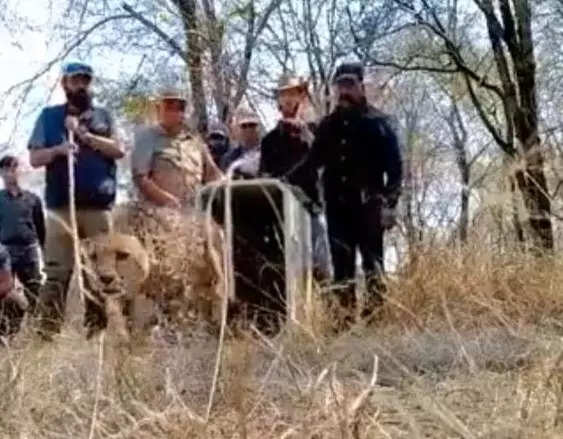The Special Task Force set up by Ministry of the EnvironmentThe Cheetah Introduction Monitoring Forestry and Climate Change in Kuno National Park, Madhya Pradesh and other suitable designated areas had therefore decided to release ‘Oban and Aasha’ in the first phase, as they were mating. Their movements would be monitored 24 hours a day by the premises State Forestry Corps staff, assisted by the Cheetah Research Group. If an animal tends to enter an undesirable environment, it would be brought back, officials said.
Great day for the cheetah reintroduction program 🐆 undertaken thanks to the decisive leadership of Prime Minister Shri… https://t.co/9ivGJMi8zG
— Bhupender Yadav (@byadavbjp) 1678548836000
Aasha is a wild cheetah female caught in a cage trap on a farm adjacent to the Cheetah Conservation Fund (CCF) center in Otjiwarongo, Namibia in July 2022. She was released onto CCF property, but was re-caught on the same farm close two months later. After. On Saturday, September 17, Indian Prime Minister Modi was given the gift of naming this Namibian cheetah after her birthday. PM Ways she chose the Indian name, Aasha, which means “hope”. Cheetah Asha was also thought to be pregnant when she was relocated from Namibia to Kuno, but she had lost her embryos, possibly due to stress, according to the Cheetah Conservation Fund (CCF). Initial medical examinations immediately following her capture in the wild had shown signs of embryos although her status also remained unclear after being taken to Kuno in the absence of testing facilities and protocols. They assume that she miscarried due to the stress that often happens with cheetahs in early pregnancy.
Oban is a male cheetah who was born at Erindi Private Game Reserve in March 2018. His dam was also born at Erinidi Reserve, and his dam was a cheetah that CCF returned to the wild in Erindi several years earlier. Oban is considered to be a second generation pup born in the wild from a rehabilitated female, evidence of successful reintroduction in Namibia.
How will the cheetahs fare once they are released into the park? Cheetahs are very adaptable. In parts of Africa where cheetahs are found, temperatures can vary between very, very hot during the day, too cold at night, and cheetahs can adapt to seasonal changes. Oban and Aasha also experience extreme rainfall and wet seasons in Africa, just like in India. Until about 75 years ago, the species lived in India, so Oban and Aasha will be able to survive most of the climatic conditions in Kuno National Park, officials say.
For hunting, cheetahs do well in open savannah and grassland environments and also in areas with moderate woody vegetation cover. They benefit from areas of tall grass or areas that allow them to remain undetected while stalking prey. Habitat at the release site in India was an important consideration and the species experts working on the project believe Oban and Sasha will fare very well with India’s landscapes.
More cheetahs would be released depending on how well Oban and Asha were in the new environment. They would be monitored and observed through radio telemetry. Once all cheetahs are established and have established home ranges/territories, homing monitoring frequency can be reduced to two-three locations per day and a good visual observation every other day to check health, condition and any sign of injury, an official said.
The Cheetah Action Plan recommended that males with GPS radio collars (more than one is called a coalition) be released from the holding pen sooner after an appropriate period of one to two months. They were expected to establish a coalition territory after exploring and studying available habitat, and tended to return to the enclosure to encounter females. Officials believed that the presence of females in the main enclosure would ensure that the males didn’t stray too far after their exploration instincts had been satiated. Remote location data from telemetry would be set for 10-12 GPS locations per day communicated via satellite/GSM communication daily. The management of Kuno NP will be responsible for monitoring essential for protection and management, while a cheetah research team will monitor for research, officials said.
The plan also recommends that the cheetah population in Kuno be intensively monitored and managed for at least 10 years with all adult cheetahs fitted with GPS/satellite collars. Research into all aspects of system restoration and interactions including the ecology, physiology and behavior of cheetahs and trends in their population as well as their prey species would be addressed by the collaborative Cheetah Research Group with the NTCA.

